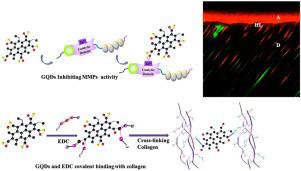Dental Materials ( IF 5 ) Pub Date : 2021-08-28 , DOI: 10.1016/j.dental.2021.07.004 Wendy Chen 1 , Huimin Jin 1 , Heng Zhang 1 , Leping Wu 1 , Guoqing Chen 1 , Hui Shao 1 , Shengrui Wang 1 , Xiaoxue He 1 , Shunli Zheng 1 , Chris Ying Cao 1 , Quan-Li Li 1

|
Objective
Resin-based dental adhesion is mostly utilized in minimally invasive operative dentistry. However, improving the durability and stability of resin–dentin bond interfaces remain a challenge. Graphene quantum dots (GQDs) reinforced by 1-ethyl-3-(3-dimethylaminopropyl) carbodiimide (EDC) were introduced to modify the resin–dentin bond interfaces, thereby promoting their durability and stability.
Methods
GQDs, EDC, and EDC+GQDs groups were designed to evaluate the effects of GQDs and EDC on collagenase activity, the interaction of GQDs with collagen, and the resin–dentin interface. First, the effects of GQDs and EDC on collagenase activity was evaluated by Collagenase (EC 3.4.24.3) reacting with its substrate. The interaction of GQDs and EDC with collagen were evaluated by cross-linking degree analysis, sodium dodecyl sulfate–polyacrylamide gel electrophoresis, attenuated total reflection Fourier transform infrared spectroscopy and enzymatic hydrolysis. Second, the acid-etched and rinse adhesive system was used to evaluate the resin–dentin bond on the basis of microtensile bond strength, in situ zymography and fluorescence confocal laser scanning microscopy.
Results
GQDs could inhibit collagenase activity. GQDs with the aid of EDC could cross-link collagen via covalent bonds and improve the anti-enzymatic hydrolysis of collagen. In the resin–dentin adhesion model, the μTBS of the EDC+GQDs group was significantly higher than the other control groups after thermocycling. The addition of EDC to GQDs could inhibit matrix metalloproteinase activity and promote the integrity of the bonding interfaces after thermocycling.
Significance
This study presents a novel strategy to modify the resin–dentin interface and provides a new application for GQDs. This strategy has the potential to improve the durability of resin-based restoration in dentistry.
中文翻译:

石墨烯量子点和碳二亚胺在促进树脂-牙本质结合耐久性方面的协同作用
客观的
基于树脂的牙科粘连主要用于微创牙科手术。然而,提高树脂-牙本质粘合界面的耐久性和稳定性仍然是一个挑战。引入由 1-乙基-3-(3-二甲基氨基丙基)碳二亚胺(EDC)增强的石墨烯量子点(GQD)来修饰树脂-牙本质键界面,从而提高其耐久性和稳定性。
方法
GQDs、EDC 和 EDC+GQDs 组旨在评估 GQDs 和 EDC 对胶原酶活性、GQDs 与胶原蛋白的相互作用以及树脂-牙本质界面的影响。首先,通过胶原酶 (EC 3.4.24.3) 与其底物反应来评估 GQD 和 EDC 对胶原酶活性的影响。GQDs和EDC与胶原蛋白的相互作用通过交联度分析、十二烷基硫酸钠-聚丙烯酰胺凝胶电泳、衰减全反射傅里叶变换红外光谱和酶水解进行评估。其次,酸蚀刻和冲洗粘合剂系统用于根据微拉伸粘合强度、原位酶谱和荧光共聚焦激光扫描显微镜评估树脂-牙本质粘合。
结果
GQDs 可以抑制胶原酶活性。GQDs在EDC的帮助下可以通过共价键交联胶原蛋白,提高胶原蛋白的抗酶水解能力。在树脂-牙本质粘附模型中,热循环后EDC+GQDs组的μTBS显着高于其他对照组。在 GQDs 中加入 EDC 可以抑制基质金属蛋白酶的活性并促进热循环后结合界面的完整性。
意义
该研究提出了一种修饰树脂-牙本质界面的新策略,并为 GQD 提供了新的应用。该策略有可能提高牙科树脂基修复体的耐久性。


























 京公网安备 11010802027423号
京公网安备 11010802027423号